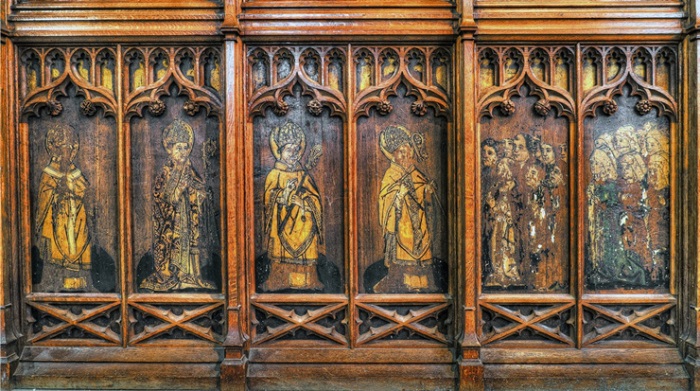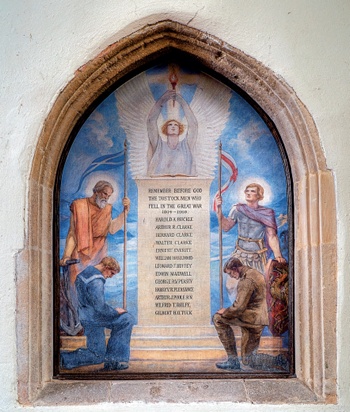100 Church Treasures
and The Altar of Sacrifice, Tostock Parish Church
Catherine Townsend and Pedro Gaspar
 |
|
| A medieval screen at St Matthew’s church in Ipswich, Suffolk from the cover of 100 Church Treasures. The campaign aims to address key threats and inspire appreciation and celebration of the nation’s ecclesiastical fine and decorative arts. The Church Buildings Council is seeking donors who can sponsor the conservation of a treasure or contribute £5,000, £10,000 or £20,000 towards the campaign. |
The Church of England’s 16,000 parish churches are among Europe’s finest historic buildings and house an unparalleled array of treasures, rivalling the collections of the world’s great museums and attracting millions of visitors each year.
Preserving these historic churches (45 per cent of England’s Grade I listed buildings in England are churches) and their treasures poses many challenges. With 16,000 churches, the size of the church’s collections is vast, and includes monuments, wall paintings, stained glass, textiles, medieval timberwork, and many other types of objects. Part of the challenge is that these treasures are the responsibility – financial and otherwise – of parochial church councils whose members are volunteers and have other pressing needs to deal with, all of which rely on fundraising. £115 million is spent on the repair of church buildings every year. The conservation of artworks costs parishes an estimated additional £3 million each year.
In 2013 the Church Buildings Council, a statutory body of the Church of England, launched a new campaign, 100 Church Treasures, to address the conservation needs of collections in parish churches. With the help of the dioceses of the Church of England, the Church Buildings Council identified 100 artworks currently most at risk in parish churches. These treasures are at risk of permanent damage and loss. The aim of the campaign is to raise funds totalling £3 million, the estimated cost of repair, and to provide financial and expert conservation support. Together this will help parishes guarantee the safe display of the 100 artworks in situ and ensure their accessibility to all.
Six months after its launch in October 2013, £179,000 has already been raised through donations and pledges. As a direct result 12 conservation reports have been commissioned and nine projects are under way including the conservation of medieval stone figures at St Paul’s, Bedford, while the repair of stained glass by pre-Raphaelite artist Edward Burne-Jones is nearing completion at St Margaret’s church, Ward End near Birmingham.
The 100 artworks included in the campaign are from parishes around England and illustrate centuries of artistic engagement with these historical buildings. One of these unique treasures is The Altar of Sacrifice at Tostock parish church, St Andrew’s, in Suffolk.
TOSTOCK PARISH CHURCH
Tostock is a traditional Suffolk village eight miles east of Bury St Edmunds. St Andrew’s is a largely 14th-century church constructed of knapped flint with limestone dressings, arranged in a chequer pattern, with slate and tile roofs. It is the parish’s only Grade I listed building.
Although the Domesday survey of 1086 records a place of worship in Tostock, the earliest components of today’s church date from the 12th century with a succession of additions and changes made into the 15th century. It consists of a Perpendicular nave (c1400) with later south porch and late 14th-century embattled square west tower. The roof of the nave dates from the 15th century, and is reported to have the second widest span in the county, supported by double hammer-beam trusses. The chancel is of the late 13th-century (early Decorated) with windows mostly of the 14th-century, and there are fragments of surviving late 15th-century glass in the east window. Sadly much of the early glass, as well as carved wooden angels from the roof, have long since been lost, perhaps as a result of a visit by the puritan William Dowsing in 1643.
In 1849 the church interior was repaired and re-seated with benches adorned with ornate carved figures including those of a unicorn, pelican and other animals, although some 15th-century benches still survive at the west end. The church was restored by JD Sedding (1839-1891) in 1872 and the chancel and its roof were restored in 1889. Although the interior has been much Victorianised, fragments of the medieval structure remain as well as some historic contents including a carved 14th-century font, bells of which the earliest dates from the 15th century, late 17th-century altar rails with turned balusters and 18th-century grave slabs laid in the chancel floor.
THE ALTAR OF SACRIFICE
In the east wall, to the south side of the chancel arch (late 13th century), and beneath an opening which would once have led to the 15th-century roodloft, is a plain 14th-century niche. It is thought that this may once have been the recess for a guild altar. Today it forms the frame to a painted canvas war memorial by the artist Marion de Saumarez (1884-1978).
Saumarez was one of three daughters of the diplomat James, 4th Lord de Saumarez. Born in London, she was brought up in Guernsey and then in Paris, where she enrolled at the Académie Julian. This French art academy was ground-breaking in that it offered women the same training in art as men. Marion exhibited at the Paris Salon and developed a successful reputation as a portraitist; the novelist MR James was one of her famous sitters.
 |
|
| The Altar of Sacrifice, the oil on canvas memorial in a niche at Tostock parish church, Suffolk, which needs urgent protection from damp and bats’ droppings (Photo: Tim Crosbie) |
Marion de Saumarez’s mother, née Jane Ann Broke, was the heiress of several large houses and land in Suffolk including Shrubland Park, near Coddenham, some 15 miles to the north-east of Tostock. The country house, which is listed Grade II*, was originally designed by James Paine in 1770-1772, and is set within parkland partly designed by Repton. Saumarez’s parents’ home was leased as a convalescent home during the first world war and she returned there to nurse the patients as a member of the British Red Cross, and to care for her ageing parents.
Given her presence in the area, a work for Tostock parish church seems to have been a natural commission, and consequently the painting, The Altar of Sacrifice, was commissioned in 1918 as a war memorial. It is interesting to note that the following year Marion completed an oil painting titled Interior of Shrubland Park Hospital, Barham, Suffolk, Showing Staff and a Patient, now part of the British Red Cross Museum and Archives collection.
The Altar of Sacrifice, an oil on canvas, depicts an epitaph inscribed with the names of those men from Tostock who lost their lives during the 1914-18 war, surmounted by an angel. On the left a sailor kneels facing the names, in front of St Andrew who holds the Scottish flag and an anchor. Opposing them is St George holding the English flag and a shield decorated with a dragon.
The painting is now in need of conservation. There is localised paint loss and evidence of mould. Moreover, the paint is not varnished and bats roosting in the church pose an additional threat as a result of their droppings and urine.
A detailed report has been commissioned by the parish and, following a survey of the painting, conservator Rosalind Whitehouse ACR set out a conservation strategy for its repair and long-term protection. The next stage of the project is to raise the necessary funds, estimated at just over £2,000. This relatively small amount would protect the painting for the next generation. The conservation of this painting is particularly timely given the commemorations of the first world war commencing this year.
~~~
Further Information
Additional information, including details and a map showing the location of the 99 other artworks can be found on the ChurchCare website. ChurchCare also provides advice on caring for war memorials, which can be seen at www.churchcare.co.uk. The Church of England has launched its own website to commemorate the centenary to bring together resources and stories from the church during the first world war, churchofengland.org/ww1.



